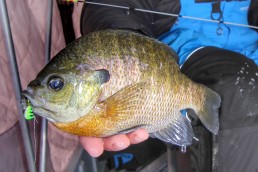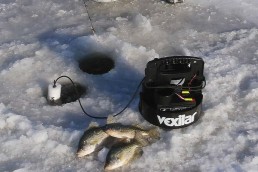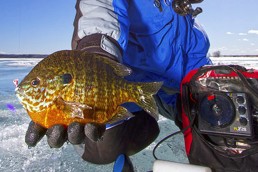Tungsten Jigs or Lead for Panfish
SHARE THIS POST
Your metal matters
In pursuit of big panfish, our travels take us across the country. We have explored big panfish patterns in reservoirs, natural lakes, farm ponds and beyond. My billfold usually has fishing licenses from a half dozen states, or more. What always amazes me, and makes fishing exciting and fun, is how we encounter different factors wherever we fish. Lake type, predators and forage all dictate fish movements and patterns. You can never assume anything. One question predominates: do I use tungsten, or lead?
You will find a scenario on a fish location, then drive five miles down the road and find a completely different set of rules. Fish enough water, and you stumble into some pretty good lessons—some which have a way of repeating.
On today’s ice-fishing scene, the merits of tungsten jigs have been a hot topic. Tungsten jigs originated in European match-fishing circles and quickly became popular here. The allure of tungsten is that the metal is much heavier than lead. A jig that is the same size as its lead counterpart sinks much faster. The extra weight of tungsten also lets ice anglers use smaller profiles. Tungsten is extremely popular right now with ice anglers, but it isn’t the end-all. There is still a time and place for lead jigs.
Tungsten craze
One big advantage of tungsten is that the added weight allows anglers to get away with heavier line. Four-pound test feels like 2-pound test. Tungsten also seems to impart more action on soft plastics when quivered in place. The drop is more abrupt and imparts more distinct action on any tentacle or tail. Horizontal tungsten jigs, tipped with a soft plastic have a larger footprint and move more water. I believe fish can feel, see and find this presentation from farther away than some other presentations. When in search mode, the tungsten and soft plastic combination is tough to beat. I love this option, as well, when looking for suspended fish in basins. Tungsten also shines for breaking down through the canopy of tall and deep weeds.
Ultimately, tungsten just flat out shines for exploiting a good bite. On a typical good bite, you will catch more fish through the day when you can reel up the fish quicker with 4-pound test and get back down to the fish quicker. You don’t have to use heavier line, but tungsten gives you that option.
Case for lead
If there is a mistake many ice anglers are making right now, it is forgetting about the advantages of lead. Traditional lead can give the ice angler a distinct edge, especially with tough bites. Perhaps the most reliable way to counter a tough bite is to decrease the presentation’s profile, make it subtler by moving less water or slowing it down. Vertical lead jigs, in particular, leave a much smaller footprint that more closely mimics small invertebrates and large zooplankton. In other situations, the slower fall of lead can trigger strikes.
Are you enjoying this post?
You can be among the first to get the latest info on where to go, what to use and how to use it!
Lead can also aid with some styles of bite detection. Remember above where we made the comment that tungsten can make 4-pound test feel like 2-pound test? The added weight of tungsten takes out any memory or coil that can develop in the heavier line, making the presentation feel more sensitive. This strategy can work well when using a spring bobber or any bite detection where you can either watch for or feel a bite with the end of the rod. When fish suck in the jig and coast forward, this style of bite detection is often optimum.
Spot bites before you feel them
In other situations, fish suck in and spit out the jig or suck in the jig and stay in one place, sometimes slowly backing up. This type of bite can be much more challenging and anglers often have to watch the line for indication of a strike instead of focusing on the rod tip. When the angler must watch the line, some coil in the line helps. This is a prime situation where lead catches fish over tungsten, because the added weight of tungsten can reduce your ability to watch for this type of bite. The toughest bites often dictate lead jigs combined with 1-pound test.
Basically, if the coil in the line gets bigger or smaller, you set the hook. On the toughest bites, this is the only way you can catch fish. For years, pockets of ice anglers used the old 4-pound and 2-pound hi-vis Stren that was discontinued years ago. In today’s world, line has gotten more specialized for ice anglers targeting panfish. My new favorite is Clam Frost Line. It features thread-diameter monofilament in 1- through 4-pound test with a high-vis orange interval for better visibility when watching the line.
Tungsten? Lead? Both.
These extremes encompass the power-fishing mindset. You fish through water fast to find fresh fish (horizontal tungsten profiles with soft plastics). The other end of the spectrum is difficult-to-trigger fish that require finesse and possibly live bait, where watching the line shows strikes (vertical lead jigs with live bait and high-vis line). The toughest question to answer when fishing is when to leave fish to find fish. The best anglers have that intuition that comes from many, many experiences––and are adept at both extremes of the presentation spectrum. The debate between tungsten and lead is not which is better, but, rather, when to use each. Tungsten brings many advantages but there will always be a place for lead.
Get ready for big fishing this spring with our Favorite Spring Fishing Destinations.
MWO
SHARE THIS POST
Did you enjoy this post?
You can be among the first to get the latest info on where to go, what to use and how to use it!
Jason Mitchell
Jason Mitchell was a top walleye guide on Devils Lake, N.D. for nearly 20 years. Today, Mitchell produces the Jason Mitchell Outdoors TV program. Visit jasonmitchelloutdoors.com for more.




